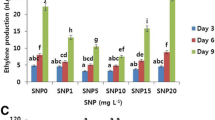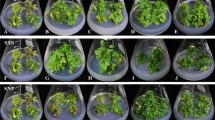Abstract
1,1-Dimethyl-4-(phenylsulfonyl)semicarbazide (DPSS)inhibited ethylene productionin carnation flowers during natural senescence, butdid not inhibit the ethyleneproduction induced by exogenous ethylene in carnationflowers, by indole-3-acetic acid (IAA) in mungbean hypocotylsegments and by wounding in winter squashmesocarp tissue. These findings suggested that DPSSdoes not directly inhibit ethylene biosynthesis fromL-methionine to ethylenevia S-adenosyl-L-methionine and1-aminocyclopropane-1-carboxylate. During naturalsenescence of carnation flowers, abscisic acid (ABA)was accumulated in the pistil and petals 2 days beforethe onset of ethylene production in the flower, andthe ABA content remained elevated until the onset ofethylene production. Application of exogenousABA to cut flowers from the cut stem end caused arapid increase in the ABA content in flower tissuesand promoted ethylene production in the flowers. These results were in agreement with the previousproposal that ABA plays a crucial role in theinduction of ethylene production during natural senescence incarnation flowers. DPSS preventedthe accumulation of ABA in both the pistil and petals,suggesting that DPSS exerted its inhibitory action onethylene production in naturally-senescing carnationflowers through the effect on the ABA-related process.
Similar content being viewed by others
References
Abeles FB, Morgan PW and Saltveit ME, Jr (1992) Ethylene in Plant Biology, 2nd ed. New York: Academic Press
Eze JMO, Mayak S, Thompson J and Dumbroff EB (1986) Senescence in cut carnation flowers: Temporal and physiological relationships among water status, ethylene, abscisic acid and membrane permeability. Physiol Plant 68: 323-328
Hyodo H, Tanaka K and Watanabe K (1983) Wound-induced ethylene production and 1-aminocyclopropane-1-carboxylic acid synthase in mesocarp tissues of winter squash fruit. Plant Cell Physiol 24: 963-969
Hyodo H, Hashimoto C, Morozumi S, Hu W and Tanaka K (1993) Characterization and induction of the activity of 1-aminocyclopropane-1-carboxylate oxidase in the wounded mesocarp tissue of Cucurbita maxima. Plant Cell Physiol 34: 665-671
Kim WT, Campbell A, Moriguchi T, Yi HC and Yang SF (1997) Auxin induces three genes encoding 1-aminocyclopropane-1-carboxylate synthase in mung bean hypocotyls. J Plant Physiol 150: 77-84
Mayak S and Dilley D (1976) Regulation of senescence in carnation (Dianthus caryophyllus). Effect of abscisic acid and carbon dioxide on ethylene production. Plant Physiol 58: 663-665
Mayak S and Dilley D (1976) Effect of sucrose on response of cut carnation to kinetin, ethylene, and abscisic acid. J Amer Soc Hort Sci 101: 583-585
Midoh N, Saijou Y, Matsumoto K and Iwata M (1996) Effects of 1,1-dimethyl-4-(phenylsulfonyl)semicarbazide (DPSS) on carnation flower longevity. Plant Growth Regul 20: 195-199
Nakajima N, Mori H, Yamazaki K and Imaseki H (1990) Molecular cloning and sequence of a complementary DNA encoding 1-aminocyclopropane-1-carboxylate synthase induced by tissue wounding. Plant Cell Physiol 31: 1021-1029
Nowak J and Veen H (1982) Effects of silver thiosulfate on abscisic acid content in cut carnations as related to flower senescence. J Plant Growth Regul 1: 153-159
Park KY, Drory A and Woodson WR (1992) Molecular cloning of an 1-aminocyclopropane-1-carboxylate synthase from senescing carnation flower petals. Plant Mol Biol 18: 377-386
Ronen M and Mayak S (1981) Interrelationship between abscisic acid and ethylene in the control of senescence processes in carnation flowers. J Exp Bot 32: 759-765
Sakai S and Imaseki H (1971) Auxin-induced ethylene production by mungbean hypocotyl segments. Plant Cell Physiol 12: 349-359
Satoh S, Oyamada N, Yoshioka T and Midoh N (1997) 1,1-Dimethyl-4-(phenylsulfonyl)semicarbazide (DPSS) does not inhibit the in vitro activities of 1-aminocyclopropane-1-carboxylate (ACC) oxidase and ACC synthase obtained from senescing carnation (Dianthus caryophyllus L.) petals. Plant Growth Regul 23: 191-193
Ten Have A and Woltering EJ (1997) Ethylene biosynthetic genes are differently expressed during carnation (Dianthus caryophyllus L.) flower senescence. Plant Mol Biol 34: 89-97
Woltering EJ, Somhorst D and De Beer CA (1993) Roles of ethylene production and sensitivity in senescence of carnation flower (Dianthus caryophyllus) cultivars White Sim, Chinera, and Epomeo. J Plant Physiol 141: 329-335
Woodson WR, Park KY, Drory A, Larsen PB and Wang H (1992) Expression of ethylene biosynthetic transcripts in senescing carnation flowers. Plant Physiol 99: 526-532
Yang SF and Hoffman NE (1984) Ethylene biosynthesis and its regulation in higher plants. Ann Rev Plant Physiol 35: 155-189
Yoshii H and Imaseki H (1981) Biosynthesis of auxin-induced ethylene. Effects of indole-3-acetic acid, benzyladenine and abscisic acid on endogenous levels of 1-aminocyclopropane-1-carboxylic acid (ACC) and ACC synthase. Plant Cell Physiol 22: 369-379
Yoshioka T, Endo T and Satoh S (1998) Restoration of seed germination at supraoptimal temperatures by fluridone, an inhibitor of abscisic acid biosynthesis. Plant Cell Physiol 39: 307-312
Author information
Authors and Affiliations
Rights and permissions
About this article
Cite this article
Onoue, T., Mikami, M., Yoshioka, T. et al. Characteristics of the inhibitory action of 1,1-dimethyl-4-(phenylsulfonyl)semicarbazide (DPSS) on ethylene production in carnation (Dianthus caryophyllus L.) flowers. Plant Growth Regulation 30, 201–207 (2000). https://doi.org/10.1023/A:1006324715438
Issue Date:
DOI: https://doi.org/10.1023/A:1006324715438




